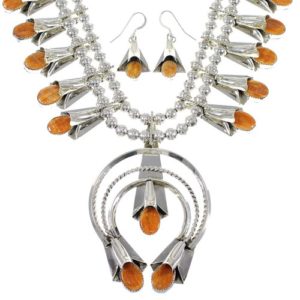
One thing that really sets Native American squash blossom necklaces apart, tribe to tribe, is the use of different stones. The size, shape, and type of stone can hold different meanings and help people determine which tribe the piece came from. Native Americans believed stones to hold certain properties, good for healing. Depending on the chosen stone, the wearer can also receive special benefits from the type of gem that is in the squash blossom piece.
One common example is the prevalent use of turquoise by the Navajo tribe. They believed turquoise to originate from the ocean and possess the healing properties of water. Turquoise is also considered a sacred gem in many cultures so there is no wonder that many cultures, especially the Navajo, use it in jewelry and art as a way to honor their heritage and culture.
There are a few common stones that are used throughout the Native tribes when making stone squash blossom necklaces.
Turquoise Squash Blossom Necklaces The blue stone is used in a lot of jewelry from Native American tribes. It’s one of the most abundant precious gems in the Southwest and has history that stretches back thousands of years in jewelry making from cultures across the world.
Tiger Eye Squash Blossom Necklaces The tiger eye necklace embodies the ferocity and spirit of the tiger itself. This stone is more common in American Southwest culture, but has been adopted by Native artists as well. The beautiful dark reds, bright oranges, and burnt browns that are present in the stone are reminiscent of a tiger’s eye; that’s where the stone gets its name.
Oyster Shell Squash Blossom Necklaces This stone is particularly breathtaking. While not technically a stone, it’s still considered a gem that has been used in jewelry for as long as turquoise. Since its origins are derived from the ocean, the shell is believed to bring peace and harmony to the wearer.
